Setup Guide: Elitech Intelligent Vacuum Pump SVP-7,9,12
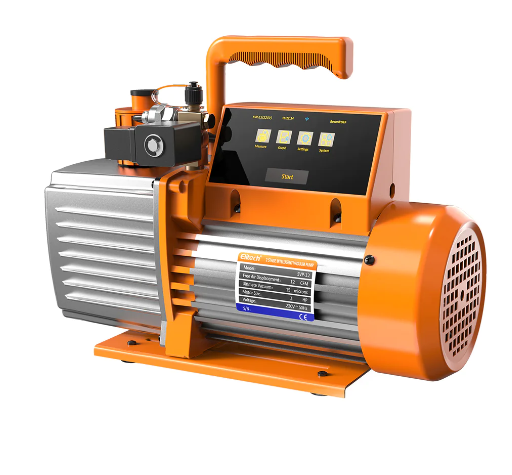
Content
Introducing the Elitech Intelligent Vacuum Pump SVP-7, SVP-9, and SVP-12
The Elitech Intelligent Vacuum Pump SVP-7, SVP-9, and SVP-12 are the latest innovations in vacuum technology. These pumps are designed for a variety of applications, including laboratory research, industrial manufacturing, and HVAC systems. With their advanced features and user-friendly design, these pumps are quickly becoming the go-to choice for professionals in a variety of fields. The SVP-7, SVP-9, and SVP-12 are available now, with estimated prices ranging from $500 to $1,500 depending on the model and features selected.
Intelligent Vacuum Pump Product Features
- Intelligent Control of Motor and Solenoid Valve
- Leakage Level Judgment
- Vacuum Change in Graph
- 4" Touch Screen Display
- Estimated Job Completion Time
- Data Logging and Storage via App
Elitech Intelligent Vacuum Pump Technical Parameters
Models | SVP-7 | SVP-9 | SVP-12 |
Stage | 2 stages | ||
Power Supply | 110V / 60HZ; 220V/50HZ | ||
Motor | AC induction motor | ||
Speed Regulation | Fixed speed | ||
Vacuum Accuracy | 1-10000microns ±10% of Reading / ±10microns 10000-19000 microns ±20% of Reading | ||
Operating Temperature | 5°C~40°C(41°F~104°F) | ||
Transmission Distance | 30ft / 10m | ||
Limit Vacuum | 15 microns | ||
Pumping Rate | 7 CFM (3L/S) | 9 CFM (4L/S) | 12 CFM (5L/S) |
Motor Power | 3/4 HP ( 550 W ) | 1 HP ( 750 W ) | 1 HP ( 750 W ) |
Fuel Volume | 22oz /(650ml) | 22 oz /(650ml) | 25.3 oz( 750ml) |
Overall Dimension | 18.5in×10.5in×14.8in / (470mm*267mm*380mm) | ||
Weight | 34.2lbs/ 14.8kg | 35.3lbs/ 15.3kg | 36.8lbs/ 16kg |
Air Inlet | 1/4 SAE ;3/8 SAE | ||
Service Parts
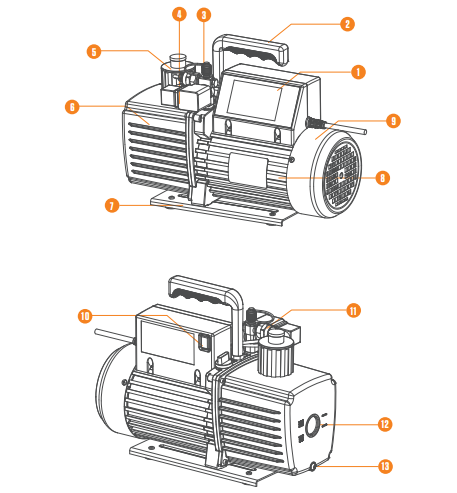
- Display screen
- Handle
- Air inlet
- Solenoid valve
- Catcher
- Oil tank
- Base
- Motor
- Motor housing
- Power button
- Vacuum sensor
- Oil window
- Oil drain plug
Operation Guide
Conditions that must be met
- Place on a flat surface.
- Confirm the voltage and frequency at the outlet match with the vacuum pump specifications.
- Confirm the oil level is within the Min and Max level.
- Remove the air inlet cap (1/4 SAE fitting as shown in the right image ), connect the pumped system (make sure the pipe fitting is fit with the air inlet fitting). Tighten the air inlet and make sure the system and hoses are sealed with no leakage.
- Plug in the power cord and open the exhaust port.
Interface Introduction
Main interface
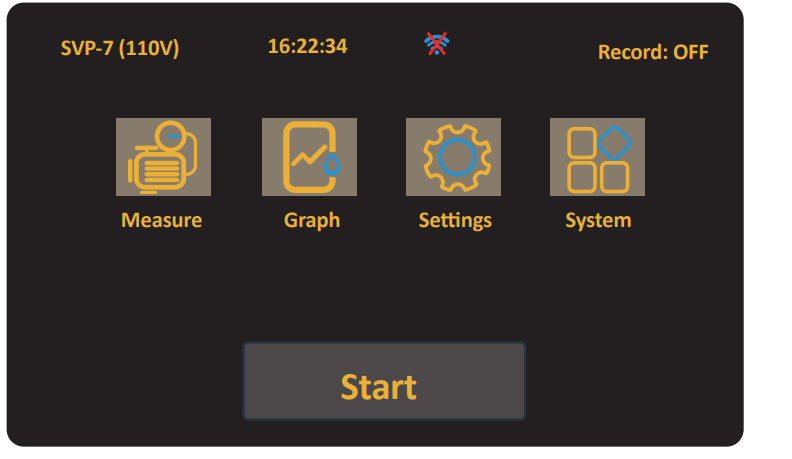
- The status bar on top of the page shows the product model, time, Bluetooth status and record status.
- Model number varies depending on the product models.
 Bluetooth not connect;
Bluetooth not connect; Bluetooth connected.
Bluetooth connected.- During operation,
 appear when temperature exceeds the upper alarm limit,
appear when temperature exceeds the upper alarm limit, and appear when temperature below the lower alarm limit.
and appear when temperature below the lower alarm limit. - Record: close means no data is recorded. Record: Open means that data is being recorded.
- The middle part of the page is the sub-interface button.
 : Real-time measurement interface
: Real-time measurement interface : Graph
: Graph : Vacuum parameter setting
: Vacuum parameter setting : System parameter display and setting
: System parameter display and setting
- The bottom part is the “Start” and “Stop” button. The motor is off by default after power-on. Click “Start” to start the motor. Button will be locked (within 3 sec); Click “Stop” to stop the motor. Button will be locked (within 10 sec). After the motor stops, in order to prevent frequent start and stop, the button is invalid within 10 seconds.
When the motor starts, the solenoid valve automatically opens instantly. The solenoid valve closes automatically after the motor stops to avoid the oil be suck to vacuum sensor.
Real time measurement interface
Click the “Measure” button on the main interface to enter the real-time measurement interface.

- Motor Status: show the current status of the motor.
- Motor Temp/Limit: show the surface temperature of the pump chassis and set the alarm temperature.
- Oil Temp/Limit: show vacuum pump oil temperature and set the alarm temperature.
- Vacuum Status: display the current vacuum value status, "Decrease", "Stable", "Rise", "--".
- Estimated End Time: when the vacuum is stable, it shows the estimated job completion time including holding time.
- Vacuum Reading Display: Vacuum readings shows when the vacuum of the system in real-time is below 60000microns. The waiting time for the vacuum reading is longer for a larger system.
Note: The vacuum reading varies due to the sensor placement different. The reading variances is caused by the uneven air flow during the vacuuming process. The farther the air from the pump, the higher the air density is thus the vacuum reading is higher. - Leakage level: when the vacuum is stable, check the leakage possibility from 0 to 100 levels. 0 represent uncertain leakage. The larger the number, the greater the possibility of the leakage.
 Key: return to the main interface.
Key: return to the main interface.
Graph
Click the “Graph” button on the main interface to view the vacuum change in real time.

- When the vacuum value drops below 60000microns, the vacuum change graph is displayed.
- The X axis represent time. Y axis represent vacuum. The vacuum value is from 0-60000microns .
 Key: return to the main interface.
Key: return to the main interface.
Settings
Click the “Settings” button on the main menu to enter the setting interface.
Unit (P/T): Select Unit to set the unit for vacuum and temperature. The selected units are in green.

Vacuum: Set the minimum vacuum value, logging interval, and recording status.
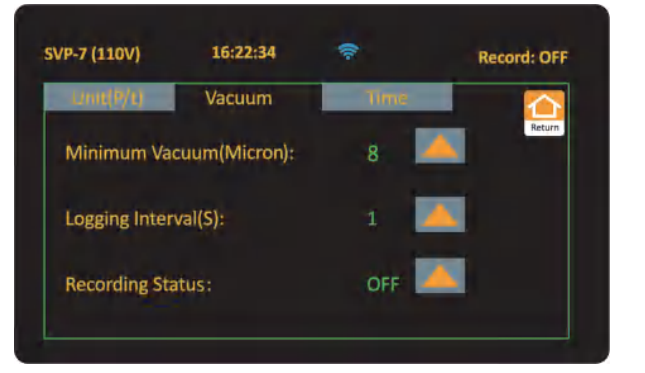
- Minimum Vacuum: set the target vacuum value. The range of the minimum vacuum value is 8-750 microns. Click the change button to switch the minimum vacuum value; the display unit changes according to the selected unit.
- Logging Interval (S): 1, 5, 10, 30, 60, 120, 300.
- Recording Status: The logging can be turned on and off. The upper right corner shows the logging/recording status.
Time
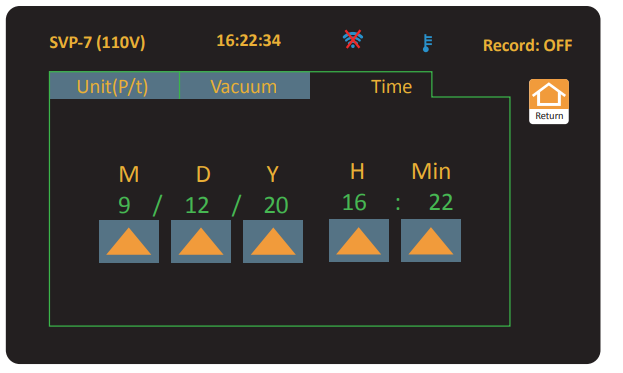
- Set and save the time then it shows at the top of the screen.
- ∧ : Change key.
 : return to the main interface.
: return to the main interface.
System
In the main menu, click the “ System” button to enter the system interface.

- Running Time: refer to the accumulated running time of the motor.
- Holding Time: refer to the time for the vacuum pump to continue vacuuming after the target vacuum value is stable.
- Flow Rate: refer to the pumping speed of the vacuum pump.
- ∧ : Change key.
 : return to the main interface.
: return to the main interface.
Other functions
Temperature alarm: When the oil temperature or motor chassis temperature exceeds the upper limit alarm temperature set by the APP, the motor and solenoid valve are closed, the temperature alarm icon "![]() " is displayed at the top of the screen; When the temperature decrease within the alarm temperature, the alarm will be cleared, and the vacuum work continues . If temperature exceeds the offline alarm temperature, the temperature alarm icon "
" is displayed at the top of the screen; When the temperature decrease within the alarm temperature, the alarm will be cleared, and the vacuum work continues . If temperature exceeds the offline alarm temperature, the temperature alarm icon " " will be displayed on the top of the vacuum pump screen, the motor operation will not be affected.
" will be displayed on the top of the vacuum pump screen, the motor operation will not be affected.
After using the vacuum pump
- Close the valve between the pump and the pumped container.
- Turn off the power switch on the pump, unplug the power plug, and remove the connecting pipe.
- Finally, close the air inlet cap to prevent dirt or floating particles from entering the pump cavity.
Vacuum Pump SVP-7, SVP-9, and SVP-12 Description
The Elitech Intelligent Vacuum Pump SVP-7, SVP-9, and SVP-12 are designed for durability and reliability, with high-quality components and a robust construction. The pumps feature a compact design, making them easy to install and move as needed. The digital control panel allows for precise pressure control and monitoring, while the automatic pressure control ensures consistent performance. The oil-less design of the SVP-7 and SVP-9 models eliminates the need for regular oil changes, reducing maintenance time and costs. The SVP-12 features an oil-sealed design for even quieter operation and longer lifespan.
Care And Maintenance
Precautions
- When the vacuum is started, the air pressure is relatively high and the pump exhaust volume is large, thus oil mist will be overflowing with a large amount of gas. This is a common phenomenon for a rotary vane vacuum pump. When the vacuum drops to a very low level, the pump exhaust volume is small, and there will be no oil mist. Therefore, user should regularly monitor the oil level via the oil window to avoid running out of oil.
- During operation, storage and transportation, keep the vacuum pump clean to prevent pollutants such as water, mechanical impurities, etc. from entering the pump so as not to affect the service life of the vacuum pump and the normal operation of the system.
- The oil in the pump should be drained if it is not used for a long time. Store the pump in a dry and clean environment.
- The diameter of the pipe is larger than the inner diameter of the air inlet to avoid affecting the pumping speed.
- Check the tightness of the pipe connection to prevent leakage. Recommend using the vacuum grease on the connection and clamp it with a clamp to ensure the seal.
- Do not use the pump to pump out gases which contain high level of oxygen, metal corrosive and explosive gases. In addition, do not pump in any gases that react with pump oil and containing large amount of water vapor.
- It is recommended to clean the catcher once every half year.
How to replace the vacuum pump oil
- Run the pump for about 3-5minutes until it is warmed up to runs out the pump oil.
- When the pump is running, open the air inlet port at the same time to let the oil flow back to the oil tank. The pump must stop when replacing the oil.
Stop the pump and open the oil drain plug. Then open the catcher to speed up the process of oil exhausting - Tilt the pump body to completely drain the residual oil, and tighten the drain plug.
- Open the catch device and add the new pump oil.
- Cover the air inlet cap and start the pump to run-check the oil level after one minute. If the oil level is below the lower limit, slowly add the oil until it reaches the normal oil level. Finally, screw on the catcher.
Pros & Cons
Pros: * Durable and reliable construction * Precise pressure control and monitoring * Automatic pressure control for consistent performance * Oil-less design (SVP-7 and SVP-9) eliminates the need for regular oil changes * Quiet operation (less than 60 dB) Cons: * Higher price point compared to some other vacuum pumps on the market * SVP-12 model requires regular oil changes
Troubleshooting Guide
Failure Phenomenon | Cause of Issue | Troubleshooting Method |
Low Vacuum | 1.Insufficient Oil | Add oil between the maximum and minimum level |
2. Pump oil Emulsified, Polluted | Replace with new oil | |
3.The Oil Inlet is Blocked or the Oil Supply is Insufficient |
Clean the oil inlet and filter | |
4. Leakage of the Pump System and Connection |
Check the system and the connection to prevent the leakage | |
5. Improper Selection of Pump | Check the size of the pumped container, recalculate and select the appropriate type of pump | |
6. Parts Wear and Tear due to Long Time Used. |
Repair or replace with a new pump | |
Oil Leakage | 1. The Oil Seal Is Damaged | Replace oil seal |
2. Loose or Damaged Tank Connections | Tighten the screws and replace the O -ring |
Fuel Injection | 1. Too Much of Oil | Drain the oil to the oil level line |
2. The Air Inlet Is Over Pressured for a Long Time |
Choose a pump with larger pumping speed | |
Difficulty Starting |
1. Oil Temperature is Too Low | Open the air inlet, start the motor repeatedly or heat up the pump oil |
2. Motor Failure | Check and repair | |
3. Foreign Objects Fallen into the Pump |
Check and clean | |
4. Power Failure | Check and repair | |
5. The Power Supply Voltage Is Too Low | Check the power supply voltage |
Customer Reviews
"I've been using the Elitech SVP-9 for several months now and it's been a game-changer for my lab work. The digital control panel is so easy to use and the automatic pressure control ensures consistent results every time." - John D. "I was hesitant to spend the extra money on the SVP-12, but I'm glad I did. The oil-sealed design is so quiet and it's been running smoothly for weeks without any issues." - Sarah K. "The SVP-7 is a great value for the price. It's easy to install and maintain, and it's been performing well for all of my vacuum applications." - Michael P.
Faqs
What are the available models of the Elitech Intelligent Vacuum Pump?
What are the primary features of the Elitech SVP-7 Intelligent Vacuum Pump?
How does the vacuum capacity vary among the SVP-7, SVP-9, and SVP-12 models?
Are the Elitech Intelligent Vacuum Pumps compatible with all refrigerant types?
Can the Elitech Intelligent Vacuum Pumps be used for applications other than HVAC and refrigeration?
What is the price range for the Elitech Intelligent Vacuum Pump models?
Do these vacuum pumps feature a built-in vacuum gauge?
What type of maintenance do the Elitech Intelligent Vacuum Pumps require?
How energy-efficient are the Elitech SVP models?
Can the Elitech Intelligent Vacuum Pumps be operated remotely?
Leave a Comment
